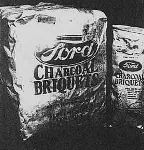|
|
|
 |
|
The History of BarbecueFrom Barbocoa to Briquet | |
|
Cooking was a big innovation for early humans and it occurred shortly after the discovery of fire. Whether that happened because someone accidentally dropped a piece of meat into a fire and then retrieved it or someone came upon an animal that had died in a brushfire and decided to eat it, we'll never know, but humans quickly realized that meat tastes a lot better cooked than it does raw. Word spread quickly and soon nearly everyone was "barbecuing" their meat. |
 |
Times were tough back then and people didn't have propane fired stainless steel grills but they managed to get along fine with just an open flame. During the Middle Ages, the use of iron pots in Europe became widespread, and Europeans discovered the ease of using large pots to boil meat, usually with vegetables and often with dumplings or pasta. Iron also permitted cooks to construct permanent or semi permanent cooking devices, so that cooking and heating could take place indoors. Other cultures, such as the Chinese, saw a similar evolution in cooking methods away from cooking over direct heat and toward a "low and slow" method. By the beginning of the Renaissance in 1453, the low 'n slow method had been all-but-forgotten for generations in Europe. When Columbus arrived in the Caribbean in 1492, he "discovered" the Taino Native Americans cooking fish and wild game hung on a wooden structure over coals. The Taino word for the wooden structure sounded to the explorers like barbacoa. The mystery of barbecue begins with the name. The Oxford English Dictionary credits the origin of the word to French-speaking Haiti. Some think it may come from the Louisiana's French "barbe a queue" or "from whiskers to tail" neat description of a whole roasted beast. Still others feel that the Spanish "barbacoa" is more likely. We'll probably never know who deserves credit, but the Spanish explorers returned to Europe with this new word and new cooking method. Because the printing press had come into use, the word of the discoveries - including barbacoa - quickly spread across Europe. Shortly thereafter, de Soto and other explorers of present-day Florida brought swine from Europe. The swine quickly spread throughout the southeast. And soon a delightful marriage of cooking method and pig would be born. When English colonists arrived in the present day United States, they brought the barbecue method with them, which they perfected in hog barbecue. In colonial America, barbeques were held as social activity by wealthy plantation owners. After George Washington laid the cornerstone of the Capitol in 1793, the assembled group dined on a barbecued 500-pound ox. William Henry Harrison attracted 30,000 voters to one colossal barbecue in Virginia. Slaves were often the cooks at barbecues and they took barbecue with them after the Civil War when they moved north. Pioneers dug trenches, filled them with wood, and cooked their meats for hours. The wood smoke flavored the meats and the slow and low heat cooking method made the barbecue tasty and easy to eat, even without teeth. Pioneers weren't renowned for their dental care and a full set of teeth was a luxury! In the late 1800s during cattle drives out West, cowboys had to be fed. The cattle barons didn't want to feed them good meat, so disposable cuts were used. The main choice was brisket, a tough, stringy piece of meat. Resourceful cowboys learned that if you left this brisket to cook for a long period of time at low heat, it would be more palatable. In the nineteenth century, barbecue was a staple at church picnics and political rallies. A barbecue was a popular and inexpensive way to lobby for votes and an easy way for different social classes to mix. Political organizers would provide barbecue, lemonade, and typically a bit of whiskey for the men. The next big breakthrough for popularizing barbeques occurred when Henry Ford invented charcoal. Ford hit upon charcoal as a way to make commercial use of the piles of wood scraps heaped up as a byproduct of his car-assembly operation. His friend Thomas Edison designed his first charcoal plant on a site selected by a Ford relative, E. G. Kingsford.
Barbecue Trivia
|
|



